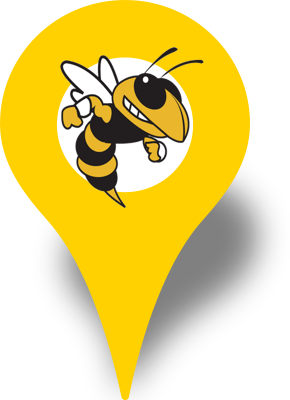Augmented Reality and the Web
Past, Present and Future
Blair MacIntyre
Principal Research Scientist, Mozilla
Professor, School of Interactive Computing, Georgia Tech
@blairmacintyre / bmacintyre@mozilla.com
Past
Background, Terminology, Technology
Present
Web and AR right now
Future
Where do we want to go, how can we get there?
But First, Why?
| Media | Mission | Mashup |
Prelinary Ideas, I am Looking for Feedback!
And Hopefully Involvement!
Past
What is AR?
(or MR or Holographic Computing?)
Mixing media with a
person's perception of the world
registered in 3D, in real-time
Other approaches to context-based media:
- Heads-up-Displays (Glass)
- Map mashups (Ingress, Pokemon GO)
- Geofencing (alerts)
Ivan Sutherland, "The Ultimate Display", mid-1960's
Authoring Tools for AR
Again: Why the Web?
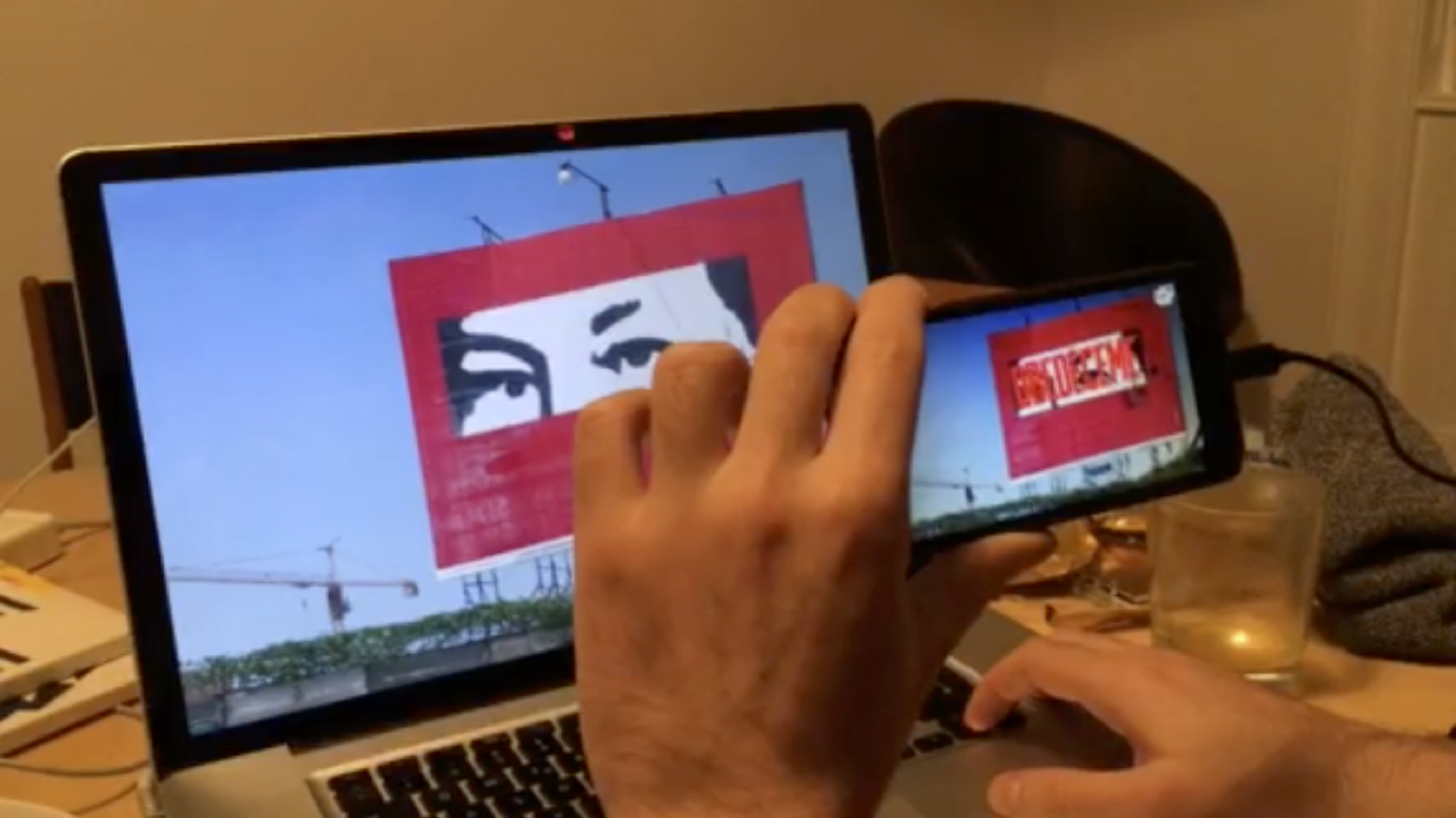

The "Current" Web is Not Quite There
Local Video: Latency, no camera intrinsics
Tracking: Overheads and Speed
W3C standards, AWE.js, various Web-for-Native plugins
AR Technology
System Setup
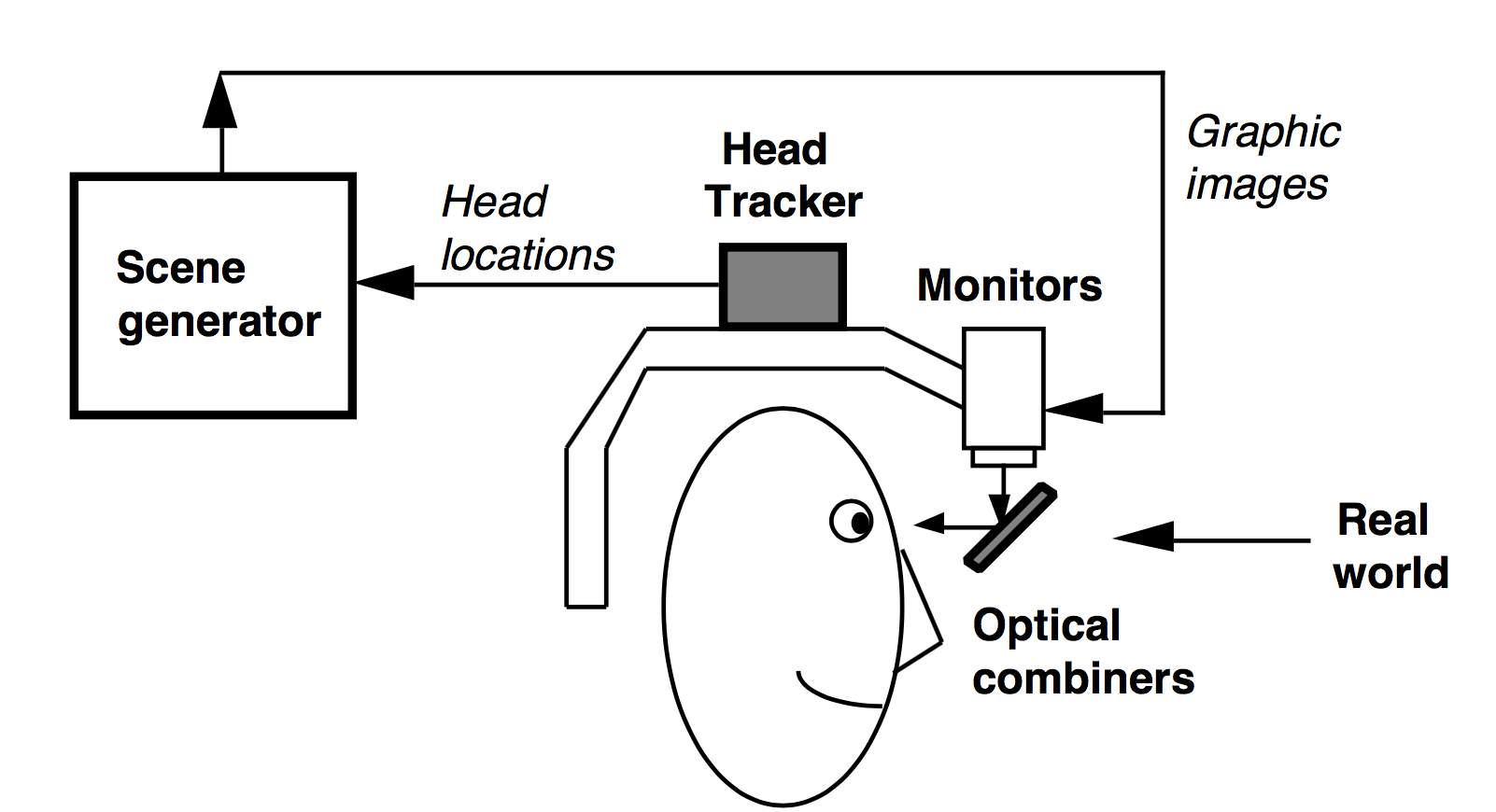

Ron Azuma. "A Survey of Augmented Reality" Presence (1997)
System Setup

Ron Azuma. "A Survey of Augmented Reality" Presence (1997)
System Setup
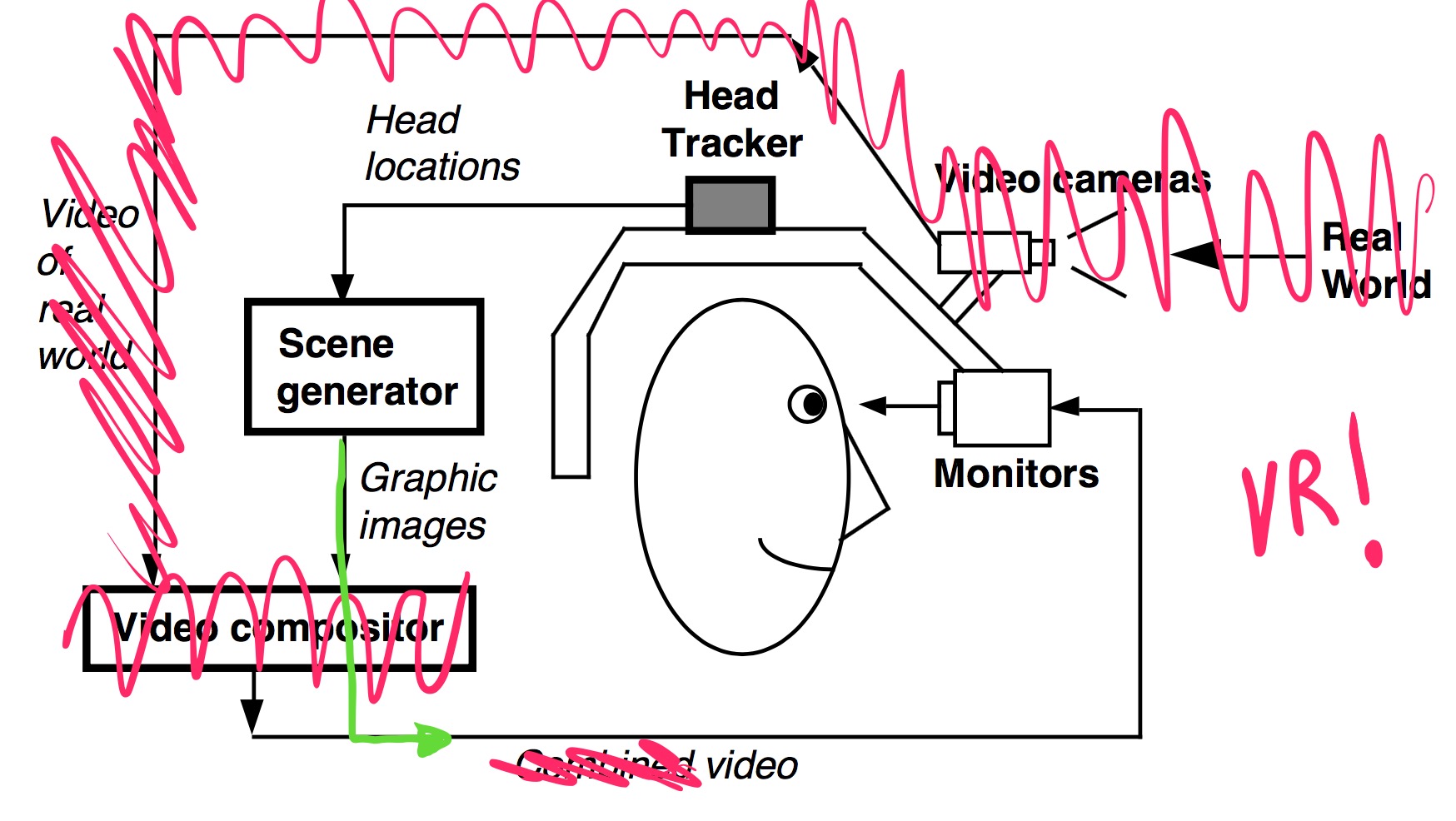
Ron Azuma. "A Survey of Augmented Reality" Presence (1997)
System Setup
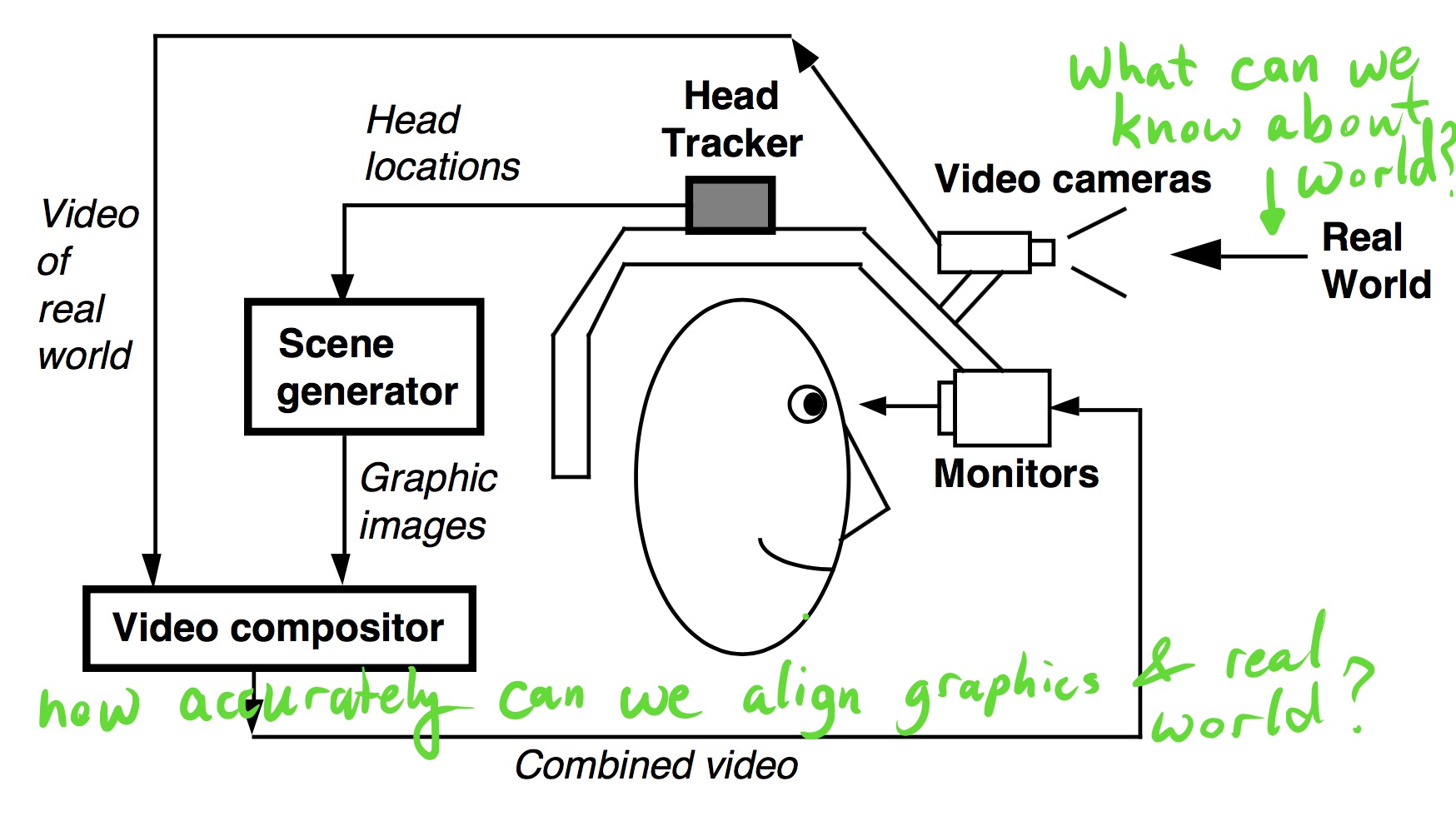
Ron Azuma. "A Survey of Augmented Reality" Presence (1997)
Can only display relative to what we
already know or can sense
about the world
Must display in real time (akin to VR)
Core problems are displays, sensing, and services for world knowledge.
Sense the world relative to display
Inside-out
(e.g., computer vision & depth sensing, object recognition)
Outside-in
(e.g., GPS, Vive Lighthouse)
Current Approaches to AR
Head Mounted Displays
(Perhaps HMD's will dominate when
they look like this, but that's a long way off)
Traditional (Handheld and Desktop) Displays
Projection Displays
Observations About Using AR
1: Intended Use
Tools vs Awareness
1: Intended Use
Tools vs Awareness
2: The "R" in "AR" Matters
AR depends on knowledge of the world
Can only augment what the system knows about
Knowledge (in apps) equals risk (for users and others)
3: Different ways to Leverage "R"
World as Massive Display Space (Structure)
3: Different ways to Leverage "R"
Recognize and/or Augment Specific Things (Semantics)
Present
This Presentation is Running in Argon4
on an iPhone
Using argon.js + reveal.js + aframe.js + argon-aframe.js
Stuff around the room
Computer vision AR w/ Vuforia
Planetary scale geographic AR
Custom Reality (Panorama)
Added Argon to reveal.js Demo
Add some new scripts up top
<script src="resources/js/aframe.js"> </script>
<script src="resources/js/argon.js"> </script>
<script src="resources/js/argon-aframe.js"> </script>
Add a simple AFrame scene down below
<ar-scene>
...
</ar-scene>
Adjust the CSS a bit, add some Javascript and we're off...
Simple Declarative 3D AR Content
<a-box position="0 3 -10" radius="0.25" color="gold"
rotation="0 0 45">
<a-animation attribute="rotation" from="0 0 45" to="0 360 45"
dur="1000" easing="ease-in-out"
repeat="indefinite">
</a-animation>
</a-box>
A-Frame markup to create a spinning gold diamond
Geospatial frames of reference
<ar-geopose id="GT" lla="-84.394539 33.772501" userotation="false">
<a-entity fixedsize="20" billboard>
<a-plane rotation="0 0 0" width="2.9" height="4" src="#buzzpin"
transparent="true" ></a-plane>
<a-entity css-object="div: #gtdiv" scale="0.02 0.02 0.02"
position="0 4 0"
showdistance="Tech Tower @ GT<br>Atlanta, GA, USA<br>It is ">
</a-entity>
</a-entity>
</ar-geopose>
A-Frame markup to put a pin at Georgia Tech
Simple Vuforia Setup and Use
<ar-scene vuforiakey="#vuforiakey"
vuforiadataset__stonesandchips="src:url(StonesAndChips.xml);">
<a-assets>
<a-asset-item id="vuforiakey" src="key.txt"></a-asset-item>
</a-assets>
<ar-frame id="frame" trackvisibility="true" visible="false"
parent="vuforia.stonesandchips.stones">
...
</ar-frame>
</ar-scene>
A-Frame markup to put content on a visual target
Web Ecosystem is Rich and Diverse
Many tools, from the simple to the elaborate
Mashups may suggest new ways of creating 3D!
Twine
(twinery.org)
Thoughts on AR plus Web
1: There will be Apps, Not Just "Content"
(or something like apps)
Non-trivial content requires code and interaction
Security and privacy require sandboxing
2: Will want to run many apps at once
Current focus on individual apps w/ full control
As with 2D/3D before, user's will want to mix and match
Mash up pages/apps, mix 2D/AR/VR content, mix displays and sensing
3: Decouple apps from "Reality"
Decoupling necessary for portability
Let app creators and users control "representation of reality"
Don't limit users to their local reality
4: AR is "just" a capability
There will still be apps, but not "AR apps"
AR something you add to a system or app
Think about what AR is good for and how it fits into web ecosystem
Future
My Hope: Mixed Media Mashups
2D + 3D + AR + VR + mobile + desktop + HMDs + ...
Focus on User choice
Web for AR/VR
and
Web in AR/VR
Plans ...
| Time Frame | Activity | Goals |
|---|---|---|
| now |
"Web Now" (w/ argon.js) |
use cases mashups w/ 2D, VR web services |
| 3-12 months |
Mozilla AR app (mobile + desktop) |
technical experiments browser interfaces |
| 1-2 years | W3C, etc | standards (WebRTC, WebVR, ...) |
| 1-3 years | Firefox (and peers) |
WebAR |
| 1-5 years | ecosystem, new devices |
HMDs, IoT, wearables, cars, ... |
Going Beyond "Web Now"
Enabling Technology
Low-latency Video Processing Pipeline
Video frames into GPU/JS + vision processing
(WebRTC, workers, WebAssembly, Servo, etc)
Flesh out Needed Services
Already massive amount of content tied to the world
(Much of it lacks altitude, is inaccurate)
Camera Intrinsics database
(Vuforia, ARToolkit)
(eventually: W3C media-capture-depth, KHRONOS OpenKCam, ...)
Need new services, for object or location-based search and discovery,
world knowledge, object recognition, ...
What Might a First AR Browser App Look Like?
How Might This Be Done Using Gecko (or Servo)?
Keep: multiple apps, custom realities
Add: live video access, custom device support (Tango, Hololens, etc)
Explore: Privacy issues
Nice Features
Efficiency
Privacy / Security
Clean Multi-app Integration
Outstanding Isses
Battery
Device position (GPS, indoor localization)
Camera intrinsics
Experiment with Browser Experience
Extend Windows+Tabs model: "webRTC+vision", enhanced WebVR
Embeddable AR/VR Gecko
AR/VR-centric: Argon, sort of. AR/VR-first?
Other: link to the world, object recognition-based, Prox
Experiment with Use Cases for Web-AR
AR at intersection of Web, context/IoT, and 3D/VR
Perhaps Aim for a Complete Experience:
A Real AR "Pokemon GO"-like Game?
Thanks!
Contact me via email: bmacintyre@mozilla.com
To try some of this yourself
- Download Argon4 for iOS
- http://argonjs.io: argon.js source code, samples & docs
https://blairmacintyre.github.io/hawaii-all-hands-2016/
